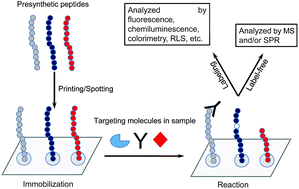The role of peptide microarrays in biomedical research
Abstract
Peptide microarrays, comprising hundreds to thousands of different peptides on solid supports in a spatially discrete pattern, are increasingly being used as high throughput screening tools with high sensitivity in biomedical science. The application of this technology to profile the antibodies, enzymes and ligands of target samples including body fluids, tissues and cells results in the discovery of new biomarkers for the precise diagnosis of diseases. Additionally, the identification of inhibitors of enzymes using peptide microarrays might offer an opportunity for the further development of enzyme-targeted drugs in a fast and efficient manner. This review provides an overview of the main peptide microarray formats currently used with their applications in the biomedical field and discusses the current challenges of this technology.

- This article is part of the themed collection: Recent Review Articles


 Please wait while we load your content...
Please wait while we load your content...